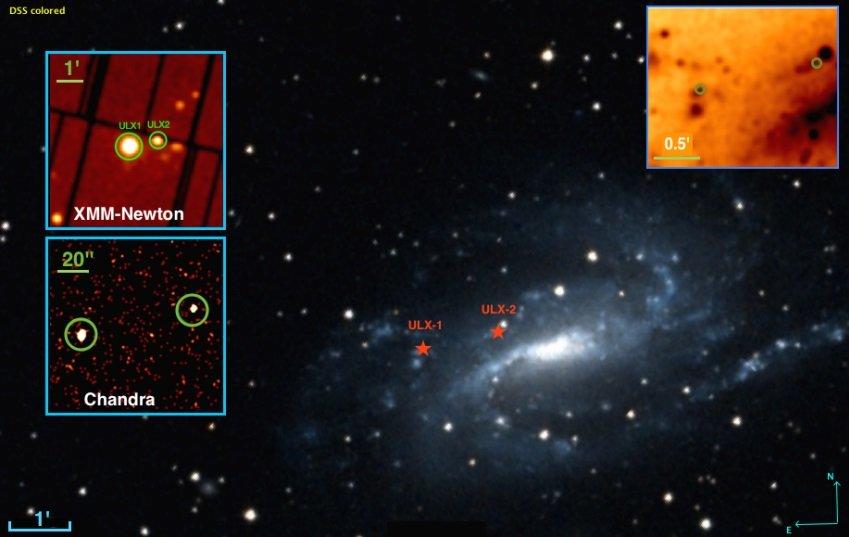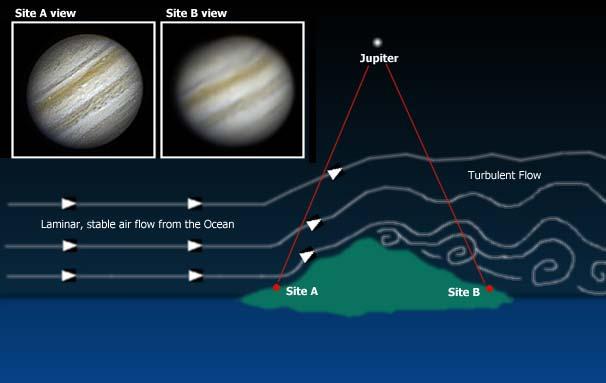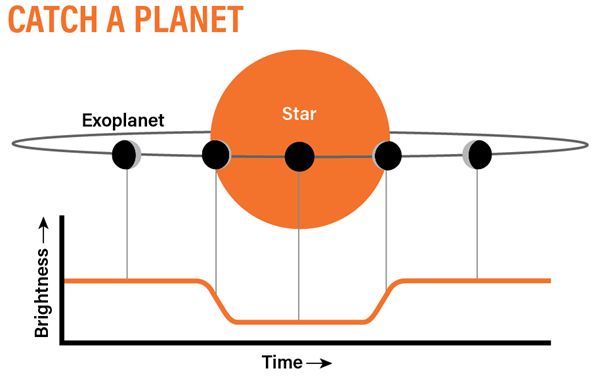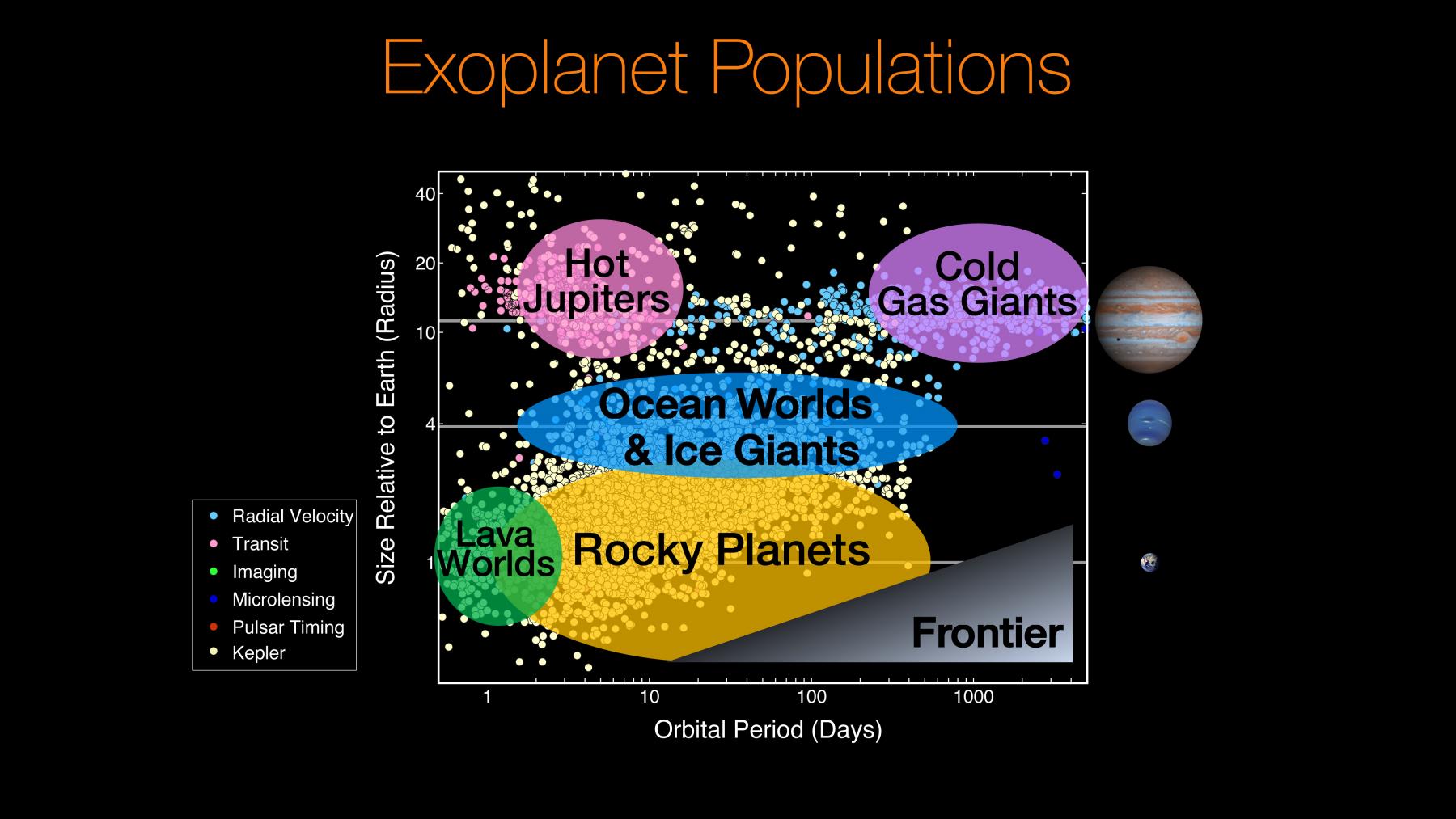UZAYMER Lisansüstü Öğrencilerin Tez Çalışmalarının Özetlerine Buradan Ulaşabilirsiniz.

NGC 4861, NGC 4449 Galaksilerinde Aşırı Parlak X-ışın Kaynaklarının X-ışın ve Optik Özelliklerinin Araştırılması
MELİKE ÖZDOĞAN ELA, 2020

Görsel Kredi: Pintore et al., 2018.
Aşırı parlak X-ışın kaynakları, galaksilerin merkez bölgesinin dışında bulunan ve Galaktik X-ışın çiftlerinden çok daha yüksek ışıtma (LX > 1039 erg s-1 ) değerine sahip çift yıldız sistemleridir. Bu çalışmada, NGC 4861 galaksisinde ULX-1, ULX-2 ve NGC 4449 galaksisinde ULX-1 kaynaklarının olası optik karşılıkları Hubble Uzay Teleskobu (HST) arşiv verileri kullanılarak ilk kez tanımlandı. NGC 4861’de yalnızca ULX-2 için hata yarıçapı 0.28" olan daire içinde iki optik aday (% 90 güvenilirlikte) belirlendi Bu adayların mutlak parlaklıkları, Mv, -6 ve -5 olarak tanımlandı. Her iki optik adayın tayfsal tipi F0I ve yaşları ~31Myıl olarak belirlendi. Bununla birlikte, NGC 4449’da ULX-1 kaynağı için hata yarıçapı 0.20" olan daire içinde (%90 güvenilirlikte) belirlenen üç optik aday için mutlak parlaklıkları -5 <Mv< -3, tayfsal tipleri B0III- B3V ve yaşları 13Myıl - 63Myıl aralığında belirlendi. En yakın yıldız kümesinden 0.25" uzaklıkta bulunan NGC 4449 ULX-1’in küme üyeleriyle benzer özellikler taşıması nedeniyle küme elemanı olma olasılığı incelendi. Ayrıca önceki çalışmalarla karşılaştırma amaçlı, Chandra ve XMM-Newton teleskoplarının yeni (kullanılmamış) arşiv verileri analiz edildi ve kaynakların X-ışın tayfsal özellikleri incelendi. Kaynakların X-ışın karakteristiklerinde belirgin bir değişimler gözlenmedi.
Investigation of X-ray and Optical Properties of Ultraluminous X-ray Sources in NGC 4861, NGC 4449 Galaxies
Ultraluminous X-ray Sources, (ULXs) are binary star systems located outside the nuclear region of galaxies and have much higher luminosities (LX> 1039 ergs-1 ) than Galactic X-ray binary systems. In this study, possible optical counterparts of ULX-1, ULX-2 sources in the NGC 4861 galaxy and ULX-1 source in the NGC 4449 galaxy were first identified using Hubble Space Telescope (HST) archival data. Only for NGC 4861 ULX-2, two optical candidates with absolute magnitudes, Mv, -6 and -5 were defined within an error radius of 0.28" (90% confidence level). Spectral types and ages of both candidates were determined as F0I and ~ 31Myrs, respectively. However, in NGC 4449, three optical candidates were identified for the ULX-1 source within an error radius of 0.20 "(90% confidence level). MV values of the optical candidates lie between −5 and −3. Their spectral types and ages are between B0III- B3V and 13Myr- 63Myr, respectively. Considering the location of ULX-1 (NGC 4449) to the nearby cluster, it was investigated whether there is an association with the cluster. In addition, for comparison with previous studies, new (unused) archival data of Chandra and XMM-Newton were analyzed and X-ray spectral properties of the sources were examined. No significant changes were observed in the X-ray characteristics of the sources.
-----------------------------------------------------------------------------------------------------------------------------------------------------------------------------------------------------------------------------------------------------------------------------------
Uydu Görüntüleri Kullanılarak Dünya Genelindeki Astronomik Gözlemevlerinin Atmosferinin İstatistiksel Analizi
ZÜHAL KURT, 2020

Çalışmanın amacı, Dünya genelinde kurulmuş 2141 astronomik gözlemevi için uydu ve model verileriden elde edilen atmosferik katmanların: bulutluluk, yoğuşabilir su buharı, aerosol optik derinlik, dikey rüzgâr hızı ve 200h-Pa basınç seviyesindeki rüzgâr hızının istatistiksel ve zamansal olarak değerlendirilmesidir. Bunlara ek olarak gözlemevlerine ait enlem, boylam ve yükseklik bilgileri dâhil edilmiştir. Gözlemevlerine ait katmanların 2002-2020 yılları arasında günlük olarak elde edilen yaklaşık 100 TB’lık uzaktan algılama ve model verilerini içeren AstroGIS veritabanı kullanılmıştır. Gözlemevlerinin aylık ve yıllık ortalamaları oluşturulmuş ve zamansal değişimler incelenmiştir. Küresel olarak seçilmiş 9 profesyonel gözlemevinin sonuçları gösterilmiştir. Katmanların histogramları üretilerek genel dağılımları incelenmiştir. Katmanların normallik testleri yapılarak normallik varsayımı sınanmış ve bu sonuca göre korelasyon (Spearman (P)) değerleri yorumlanmıştır. Tüm gözlemevleri için ortalama bulutluluk, yoğuşabilir su buharı, aerosol optik derinlik miktarı, dikey rüzgâr hızı ve 200h-Pa basınç seviyesindeki rüzgâr hızı sonuçları sırasıyla % 67, 13.85 mm, 1.81, 0.04 Pa sିଵ ve 21.06 m sିଵ dir. Profesyonel gözlemevleri dışındaki tüm gözlemevleri incelediğimiz astronomik kriterler açısından uygun olmayan yerlerde kurulduğu belirlenmiştir.
Statistical Analysis of The Atmosphere of Astronomic Abservatories Asing Satellite Images
The aim of the study is to evaluate the atmospheric layers obtained from satellite and model data for 2141 astronomical observatories established around the world: cloudiness, precipitable water vapor, aerosol optical depth, vertical velocity wind speed and wind speed at 200h-Pa pressure level statistically and temporally. In addition, latitude, longitude and altitude information of observatories are included. The AstroGIS database, which contains approximately 100 TB of remote sensing and model data obtained daily between 2002-2020, of the layers belong to the observatories was used. Monthly and annual averages of the observatories were established and temporal changes were examined. Results from 9 globally selected professional observatories are shown. Histograms of the layers were produced and their general distributions were examined. The normality tests of the layers were tested and the normality assumption was tested and the correlation (Spearman (P)) values were interpreted according to this result. Yearly mean of cloud cover, precipitable water vapor, aerosol optical depth, vertical velocity wind speeds and wind speet at 200h-Pa pressure level for all observatories were % 69.65, 13.85 mm, Pa sିଵ and 21.06 m sିଵ respectively. It has been determined that all observatories, except professional observatories, are established in places that are not suitable for the astronomical criteria we have examined.
--------------------------------------------------------------------------------------------------------------------------------------------------------------------------------------------------------------------------------------------------------------------------------------
Geçiş Zamanları Değişimi Yöntemiyle Hat-P-16b ve Tres-3b Ötegezegenlerinin İncelenmesi
YASEMİN ALADAĞ, 2021

Bu çalışmada, HAT-P-16b ve TrES-3b ötegezegenlerinin geçiş gözlemleri Ç.Ü. UZAYMER Gözlemevi'nde 50 cm Ritchey Chretien tipi teleskobu ile gerçekleştirilmiştir. Veri analizleri ve modelleme sonuçlarıyla ağırlıklı ortalama hesaplanarak ötegezegen ve barınak yıldızı için sistem parametreleri elde edilmiştir. Bu parametrelerden HAT-P-16 sistemi için: Mp=4.172± 0.163MJ, Rp= 1.309 ± 0.111 RJ, M*= 1.212 ± 0.002 M⊙, R*= 1.232 ± 0.001 R⊙ ve [Fe/H] = + 0.165 ± 0.006 dex olup Buchhave ve ark. (2010) çalışmasında verilen değerler ile uyumludur. TrES-3 sistemi için ise: Mp=1.959 ± 0.111 MJ, Rp=1.306 ± 0.169 RJ, M*= 0.947 ± 0.005 M⊙, R*= 0.819 ± 0.05 R⊙ ve [Fe/H] = - 0.190 ± 0.001 dex olup O'Donovan ve ark. (2007) çalışmasında sunulan değerler ile uyumludur. Literatür ve açık veritabanlarındaki geçiş ışık eğrilerinden elde edilen geçiş zamanları kullanılarak HAT-P-16b için Lomb-Scargle (LS) periyodogramı sonucunda anlamlı Geçiş Zamanları Değişimi (TTV) bulgusuna rastlanılmamıştır. Bununla birlikte TrES-3b verilerinden elde edilen LS periyodogramı sonucunda 32.38 günlük bir baskın dönem ve 41.07 günlük ikincil dönem tespit edilmiştir.
Analysis of hat-p-16b and tres-3b exoplanets by the transition time change method
In this study, the transit observations of HAT-P-16b and TrES-3b exoplanets were carried out at the Ç.Ü. UZAYMER Observatory with a 50 cm Ritchey Chretien type telescope. System parameters for exoplanet and host star have been obtained by calculating weighted average with data analysis and modeling results. Some of these parameters for HAT-P-16 systems are: Mp=4.172 ± 0.163 MJ, Rp= 1.309 ± 0.111 RJ, M*=1.212 ± 0.002 M⊙, R*= 1.232 ± 0.001 R⊙ and [Fe/H] = + 0.165 ± 0.006 dex these parameters are compatible with the values given in Buchhave et al. (2010). The Mp=1.959 ± 0.111 MJ, Rp=1.306 ± 0.169 RJ, M*=0.947 ± 0.005 M⊙, R*= 0.819 ± 0.05 R⊙ and [Fe/H] = - 0.190 ± 0.001 dex parameters were calculated for the TrES-3 system. These values are also compatible with the values given in O'Donovan et al. (2007). No significant Transit Timing Variations (TTV) was found as a result of the Lomb-Scargle (LS) periodogram for HAT-P-16b by using the transit times obtained from tha transit light curves in the literatüre and open databases. However, a dominant period of 32.38 days and a secondary period of 41.07 days were determined as a result of the LS periodogram obtained from the TrES-3b data.
--------------------------------------------------------------------------------------------------------------------------------------------------------------------------------------------------------------------------------------------------------------------------------------
WASP-10b VE WASP-93b Ötegezegenlerinin Geçiş Zamanlamasındaki Değişimlerinin Gözlenmesi
Mahmut TEKEŞ, 2022

Görsel Kredi: NASA/Ames Research Center/Natalie Batalha/Wendy Stenzel
Bu tez çalışmasında, WASP-10b ve WASP-93b ötegezegenlerinin geçiş gözlemleri Çukurova Üniversitesi UZAYMER Gözlemevi'nde bulunan 50 cm (UT50) Ritchey Chretien tipi teleskobu ile gerçekleştirilmiştir. Tez kapsamında seçilen iki ötegezegen için UT50 verilerinin yanı sıra; ATA50, IST60, TUGT100 teleskopları ve TESS uydusunun verileri de analizlerimize dahil edilmiştir. Çalışmamızda, veri analizleri ve modelleme sonuçlarını kullanarak ötegezegen ve barınak yıldızı için sistem parametreleri elde edilmiştir. WASP-10 yıldız sistemi için belirlenen paramatreler: Mp= 3.2218±0.3936MJ, Rp= 1.0945±0.2077RJ, M*= 0.7238±0.0124M , R*= 0.6993±0.1172R ve [Fe/H]= +0.0153±0.0102 dex olup Bonomo ve ark. (2017) çalışmasında verilen değerler ile uyumludur. WASP-93 yıldız sistemi için ise: Mp= 1.5881 ±0.1341MJ, Rp= 1.4813 ±0.16063RJ, M*= 1.4044 ±0.0071M , R*= 1.5583 ±0.0057R ve [Fe/H]= +0.0616 ±0.0209dex olup Hay ve ark. (2016) çalışmasında sunulan değerler ile uyumlu olduğu belirlenmiştir. Çalışmamız kapsamında analiz ettiğimiz tüm verilerden yararlanarak oluşturulan geçiş ışık eğrilerinden elde edilen geçiş zamanları kullanılarak WASP-10b ve WASP-93b için Lomb-Scargle (LS) periyodogramı sonucunda anlamlı Geçiş Zamanları Değişimi (TTV) bulgusuna rastlanılmamıştır.
Observation of WASP-10b VE WASP-93b explanations for change in transition timing
Transit observations of WASP-10b and WASP-93b exoplanets are conducted in this thesis using the 50 cm (UT50) Ritchey Chretien type telescope at Çukurova University UZAYMER Observatory. In addition to the UT50 data for the two exoplanets selected within the scope of the thesis; data from the ATA50, IST60, TUGT100 telescopes and the TESS satellite are also included in our analysis. In our study, system parameters for exoplanet and host star are obtained by using data analysis and modeling results. These parameters for the WASP-10 star system are: Mp=3.2218±0.3936MJ, Rp=1.0945±0.2077RJ, M*=0.7238±0.0124M , R*=0.6993±0.1172R and [Fe/H]=+0.0153±0.0102dex and these results are consistent with the values given in the Bonomo et al. (2017). For the WASP-93 star system: Mp=1.5881±0.1341MJ, Rp=1.4813±0.16063RJ, M*=1.4044±0.0071M , R*=1.5583±0.0057R and [Fe/H]=+0.0616 ±0.0209dex and these results are also consistent with the values given in Hay et al. (2016). No significant Transition Time Variations (TTV) were found as a result of the LombScargle (LS) periodogram for WASP-10b and WASP-93b based on their transit times obtained from all the transit light curves analyzed within the scope of our study.
--------------------------------------------------------------------------------------------------------------------------------------------------------------------------------------------------------------------------------------------------------------------------------------
V1302 Her Örten Çift Sisteminin Fotometrik Verilerle İncelenmesi
HALİL BAĞIŞ, 2022

Görsel Kredi: Wikimedia, NASA
Bu çalışmada UZAYMER UT50 ve NASA’nın TESS teleskoplarıyla alınan veriler ile W UMa türü örten çift sistem V1302 Her ‘in fotometrik analizleri yapıldı. Sisteme ait ışık elemanları ve minimum zamanları belirlendi. Ayrıca ışık eğrisi çözümünden ilk kez fiziksel ve geometrik parametreler tanımlandı, Roche modellemesi yapıldı. Dönem (periyot), kütle ve yarı-büyük eksen arasındaki bağıntılar ile bu sisteme ait diğer parametreler hesaplandı. Sonuç olarak, sistemin hangi W UMa alt türüne ait olabileceği elde edilen parametreler ışığında tartışıldı.
Analysis of V1302 Her Eclipsing Binary System With Photometric Data
In this thesis, photometric analysis of V1302 Her W UMa type eclipsing binary systems was performed with the data taken by UZAYMER UT50 and NASA TESS telescopes. Light elements and times of minima were obtained from the photometric analysis of V1302 Her system. In addition, physical and geometric parameters were determined from the light curve solutions obtained and a Roche geometry modeling of the system was made for the first time. The relations between period, mass and semi-major axis and the other parameters of this system were also calculated, and its type within the W UMa family of eclipsing binary systems is discussed.




